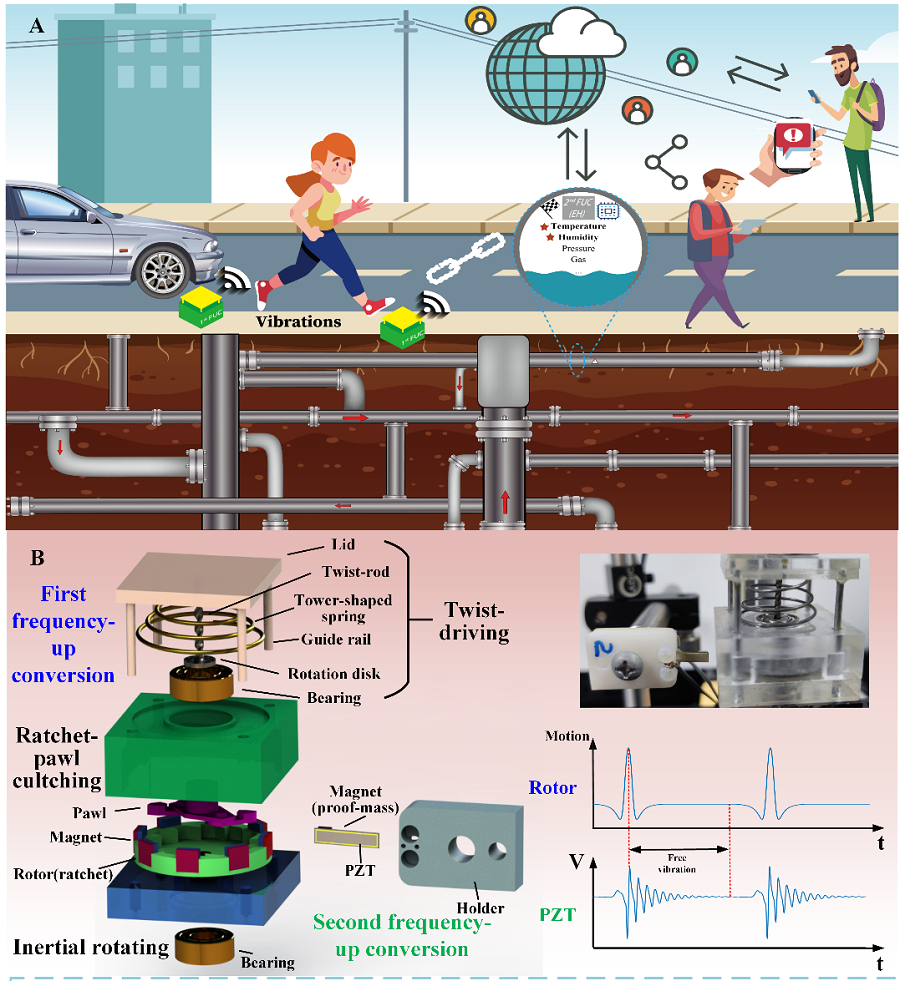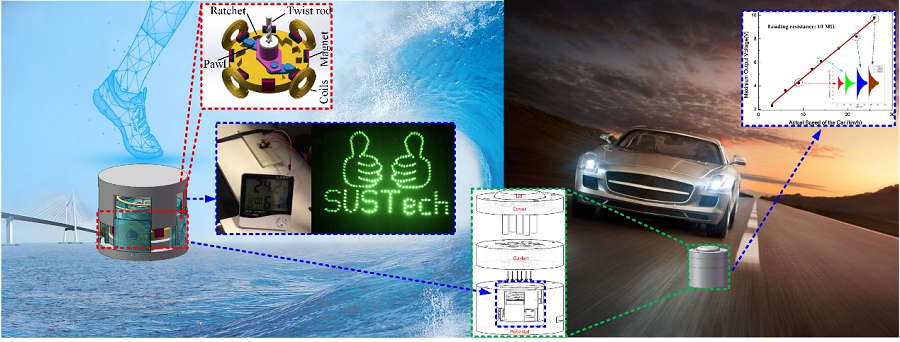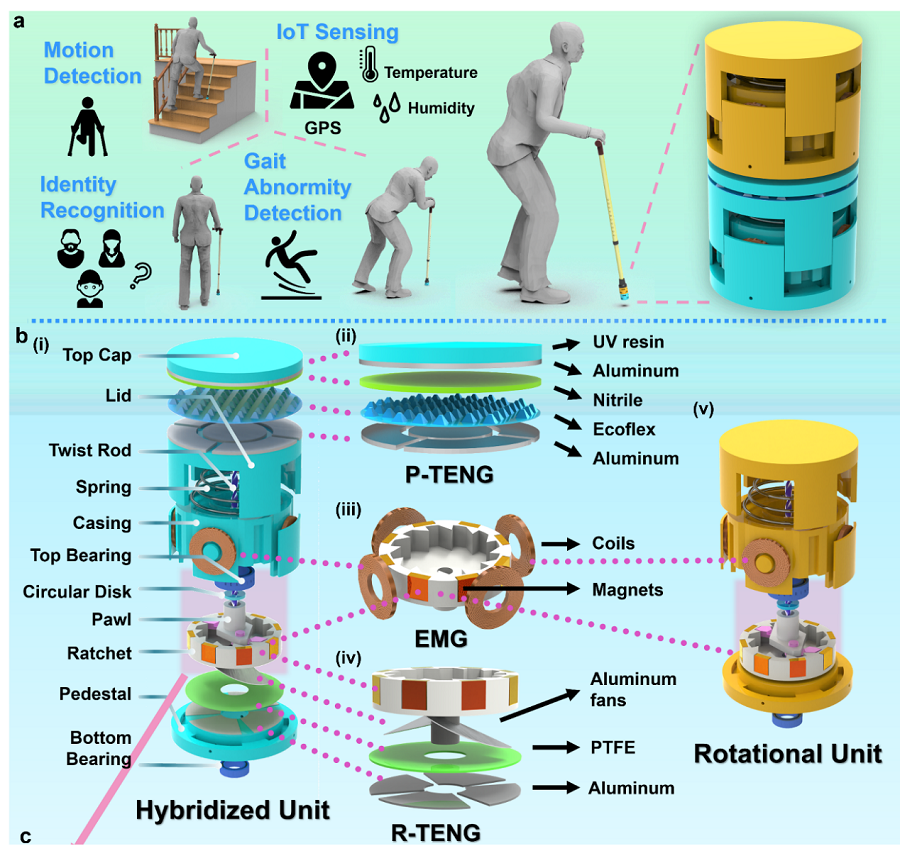current location :home>News
In recent years, with the rapid development of the integrated circuit (IC) and microelectromechanical systems (MEMS) technologies, the internet of things (IoT) and wireless sensor networks (WSN) have been applied in many scenarios such as machinery monitoring, home automation, personal health management, and marine information acquisition. All of these electronic devices need an external power supply, which is generally provided by batteries. However, these batteries have many limitations, including the requirement of periodic maintenance, short lifetime, and potential environmental pollution.
Recently, vibration energy harvesting has been proposed and considered as a reliable and sustainable energy to replace the conventional battery. This technology can harvest vibration energy from the ambient environment and convert it into electricity. However, traditional energy harvester exhibits a low energy conversion efficiency in the low-frequency vibration environment, which is not suitable as a reliable power source. Therefore, the application scenarios of vibration energy harvester should be discovered.

Associate Professor Fei Wang’s research group from the School of Microelectronics at the Southern University of Science and Technology (SUSTech) has recently published their developments in a series of energy harvesters at low frequency, and achieved multiple application demonstrations. Their research could dramatically contribute to the development of self-powered technology.
Their studies have been published in high-level journals, including Nano Energy, Applied Energy, and ACS Nano.
Self-powered wireless sensor network for sealed pipeline sensing in smart city
Due to the fast-growing population and rapid development of urbanization, cities are getting much more enormous and complex than ever. To guarantee people’s daily routines and productions, even the underground space is fully utilized for pipeline and metro construction. Equipping wireless sensor networks to monitor their operating conditions has been proposed as an effective method for constructing a smart city. However, the energy source is still one of the major limitations preventing its large-scale application.
Under this circumstance, Prof. Wang’s group proposed a vibration energy harvester with a double frequency-up conversion mechanism that can be applied to harvest energy from vibrations at ultra-low frequencies. The device can initially up-convert the external vibrations with sub-Hertz into tens of Hertz, and further convert to hundreds of Hertz, which gives a high conversion ratio of 8400. Benefiting from the non-contact design, the device could be applied in some sealed scenarios for smart city construction.
This study, entitled “Vibration energy harvester with double frequency-up conversion mechanism for self-powered sensing system in smart city,” was published in Nano Energy.
Anxin Luo, a postdoctoral fellow from the School of Microelectronics, is the first author of this paper. Weihan Xu, a Ph.D. student from the School of Microelectronics, is the co-first author, and Assoc. Prof. Fei Wang is the corresponding author. Assoc. Prof. Chengkuo Lee from the National University of Singapore (NUS) also contributed to this work.

Figure 1. Smart city with proposed VEH and double frequency-up conversion mechanism. (A) Harvesting energy from vibrations in the city can be a possible method for providing stable power resources for wireless sensor nodes in an underground environment. (B) 3D schematic of the proposed double frequency-up conversion energy harvester, where the device is composed of the first FUC inertial rotary structure and a PZT beam.
Self-powered wearable device and self-powered vehicle speed sensor
Apart from the self-powered wireless sensor network, wearable also plays an important role in human’s daily life. However, the requirement of routine battery recharge can also be an inconvenience for consumers. Based on this issue, the group proposed an inertial rotary energy harvester for human motion at low frequency.
The device mainly consists of a twist-driving system, a pawl-ratchet clutch system, and a magnet-coil transduction system. With the twist-driving system, the linear motion from vibration can be converted to high-speed rotation of the disk. The pawl-ratchet clutch system is designed to deliver and store the kinetic energy during vibration and keep rotating inertially during the interval between two impacts. The magnet-coil transduction system is applied to transfer the kinetic energy to electricity.
With a single compression, the device can achieve a high maximum energy conversion efficiency of 97.2%. An average power of 85 mW has been successfully harvested with a running speed of 9 km/h, which is enough to provide power to wearable devices.
This study, entitled “An inertial rotary energy harvester for vibrations at ultra-low frequency with high energy conversion efficiency,” was published in Applied Energy. Meanwhile, this work was reported by SCILight, a journal that showcases the most interesting research across the physical sciences, commenting that “Though the output power of the technology is still low, it can be used in a variety of low-power applications from environmental monitoring, such as temperature and humidity sensors, or motion trackers”.
Anxin Luo is the first author of this paper, while Assoc. Prof. Fei Wang is the corresponding author. Yan Lu from the University of Macau and Kangqi Fan from Xidian University also contributed to this work.

Figure 2. Self-powered wearable device and self-powered vehicle speed sensor.
Self-powered motion monitoring artificial intelligence-enabled caregiving walking stick
The increasing population of the elderly and motion-impaired people brings a huge challenge to our social system. However, the walking stick as their essential tool has rarely been investigated into its potential capabilities beyond basic physical support, such as activity monitoring, tracing, and accident alert.
Here, the researchers reported a walking stick powered by ultralow-frequency human motion and equipped with deep-learning-enabled advanced sensing features to provide a healthcare monitoring platform for motion-impaired users. Two kinds of self-powered triboelectric sensors are proposed and integrated to extract the motion features of the walking stick. Augmented sensing functionalities with high accuracies have been enabled by deep-learning-based data analysis, including identity recognition, disability evaluation, and motion status distinguishing. Furthermore, a self-sustainable IoT system with global positioning system tracing and environmental temperature and humidity amenity sensing functions was obtained.
Combined with the aforementioned functionalities, this walking stick was demonstrated in various usage scenarios as a caregiver for real-time well-being status and activity monitoring. The caregiving walking stick shows the potential of being an intelligent aid for motion-impaired users to help them live life with adequate autonomy and safety.
This study, entitled “Artificial intelligence-enabled caregiving walking stick powered by ultra-low frequency human motion,” was published in ACS Nano.
The work was a collaborative effort between SUSTech and NUS. Weihan Xu is the co-first author of this paper. Assoc. Prof. Fei Wang from SUSTech and Assoc. Prof. Chengkuo Lee from NUS are the corresponding authors.

Figure 3. (a) Schematics of the caregiving walking stick for realizing multifunctional applications for users. The human model is reproduced with permission from turbosquid.com. (b) Schematics of the hybridized unit and the rotational unit.
These studies were supported by the National Natural Science Foundation of China (NSFC), Science, Technology and Innovation Commission of Shenzhen Municipality, and China Postdoctoral Science Foundation.
Paper links (In order of appearance above):
Nano Energy: https://doi.org/10.1016/j.nanoen.2022.108030
Applied Energy: https://www.sciencedirect.com/science/article/pii/S0306261920312496
ACS Nano: https://pubs.acs.org/doi/10.1021/acsnano.1c04464?cookieSet=1